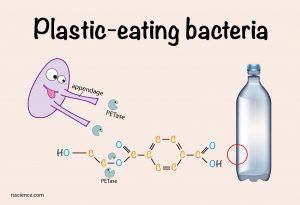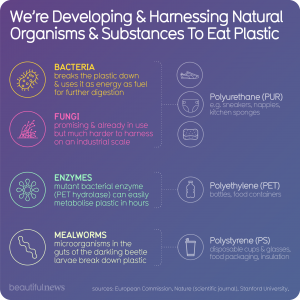Discovery of plastics
A century ago, the discovery of plastics brought the convenience of a strong and affordable structure. However, finding something so strong and easily disposable creates environmental concerns. Science is rapidly developing to accommodate issues caused by the developments. Science has now permitted the development of bacteria to decompose the plastics that have long contaminated Earth. Using bacteria to destroy plastics may be a long-term sustainable way to preserve the planet.
Plastics and their damage
Plastics are continuing to plague and damage Earth’s environment. Single-use plastics are wasteful and environmentally unfriendly. More than 8.3 billion tons of plastics were manufactured since the 1950s, and over 60% have been buried in landfills. Plastic waste ends up in rivers, dumps, and oceans. Plastics harm aquatic life, increase disease spread, and may lie in waste for centuries. Scientifically, there needs to be a method to destroy PET’s (Polyethylene terephthalate). PET’s common uses include water bottles and plastic containers, many of which are consumed once then immediately disposed of. PET’s are not biodegradable.

Source: rsscience.com
The chemical composition of PET allows bacteria to decompose the structure. The bacteria are capable of decomposing the polyester bond. The C, H, and O bonds are capable of being decomposed by the bacteria.
Bacteria: a solution?
In March 2016, there was a breakthrough scientific discovery. Japanese scientists found that bacteria could consume PET plastics. The idea of bacteria eating plastics empowers the thought of opening industry scale to demolish plastics. The plastic-eating bacteria could open doors to many other forms of waste that would end up in landfills. In 2017, the fungus Ideonella Sakaiensis was seen to be able to decompose plastics. In 2020, strains of bacteria were seen as capable of eating polyurethane plastics.

Implications
Researchers and industry are far from determining measures to implementing bacteria that will safely and quickly decompose plastics. Further research must be done to seek if the measures are truly environmental. There are unknowns of the side effects of bacteria decomposing plastic. There are uncertainties if toxins to the environment will harm the environment in the long run. Moreover, the rate of decomposition of plastics is currently too slow. There needs to be genetic engineering for faster industrial processes.

Source: Beautiful News Daily
The different forms of bacteria decompose different plastics. Bacteria mainly break down Polyurethane, and bacterial enzymes mainly break down Polyethylene. Mealworms are capable of decomposing Polystyrene. These are all plastics that contaminate the planet.
Developments moving forward
Scientists are currently working on implementing the enzymes of bacteria to break down plastics at a rate six times faster than the current rate. Recently, 12000 new enzymes having the capability of breaking down plastics were discovered. 60% of these newly determined enzymes are unclassified. These enzymes have the potential for industrial use to break down environmentally harmful plastics. With the progress of science, there are many adaptable forms of preserving the environment.
